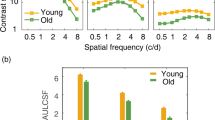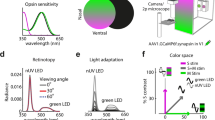Abstract
Visual contrast sensitivity is poor in newborn human infants, but improves rapidly to approach adult levels by 8 months of age1,2,3,4,5. During this period, infant sensitivity can be limited by physical factors affecting photon capture, such as eye size and photoreceptor density6,7. Here we show that infant visual sensitivity is also limited by high levels of noise in the neural transduction process. Using a non-invasive electrophysiological measurement8,9,10 and a visual noise titration technique11, we have found that intrinsic neural noise in neonates is approximately nine times higher than in adults. As intrinsic neural noise decreases during infancy, contrast sensitivity improves proportionally, suggesting that neural noise places critical limits on contrast sensitivity throughout development. Moreover, contrast gain control12, an inhibitory process that adjusts visual responses to changing stimulation, is in place and operating in infants as young as 6 weeks of age, in spite of high levels of neural noise and significant immaturities in contrast sensitivity. The contrast gain control that we observed in human neonates may serve as a building block for more complex forms of visual inhibition, which develop later in infancy13.
This is a preview of subscription content, access via your institution
Access options
Subscribe to this journal
Receive 51 print issues and online access
$199.00 per year
only $3.90 per issue
Buy this article
- Purchase on Springer Link
- Instant access to full article PDF
Prices may be subject to local taxes which are calculated during checkout



Similar content being viewed by others
References
Atkinson, J., Braddick, O. & Braddick, F. Acuity and contrast sensitivity of infant vision. Nature 247, 403–404 (1974).
Harris, L., Atkinson, J. & Braddick, O. Visual contrast sensitivity of a 6-month-old infant measured by the evoked potential. Nature 264, 570–571 (1976).
Norcia, A. M., Tyler, C. W. & Hamer, R. D. High visual contrast sensitivity in the young human infant. Invest. Ophthalmol. Vis. Sci. 29, 44–49 (1988).
Norcia, A. M., Tyler, C. W. & Hamer, R. D. Development of contrast sensitivity in the human infant. Vision Res. 30, 1475–1486 (1990).
Pirchio, M., Spinelli, D., Fiorentini, A. & Maffei, L. Infant contrast sensitivity evaluated by evoked potentials. Brain Res. 141, 179–184 (1978).
Banks, M. S. & Bennett, P. J. Optical and photoreceptor immaturities limit spatial and chromatic vision of human neonates. J. Opt. Soc. Am. 5, 2059–2079 (1988).
Wilson, H. R. Development of spatiotemporal mechanisms in the human infant. Vision Res. 28, 611–628 (1988).
Norcia, A. M., Clarke, M. & Tyler, C. W. Digital filtering and robust regression techniques for estimating sensory thresholds from the evoked potential. IEEE Engng Med. Biol. 4, 26–32 (1985).
Norcia, A. M., Tyler, C. W., Hamer, R. D. & Wesemann, W. Measurement of spatial contrast sensitivity with the swept contrast VEP. Vision Res. 29, 627–637 (1989).
Tyler, C. W., Apkarian, P., Levi, D. M. & Nakayama, K. Rapid assessment of visual function: an electronic sweep technique for the pattern evoked potential. Invest. Ophthalmol Vis. Sci. 18, 703–713 (1979).
Pelli, D. G. in Vision: Coding and Efficiency(ed. Blackmore, C.) 1–24 (Cambridge University Press, Cambridge,(1990)).
Bonds, A. B. Temporal dynamics of contrast gain in single cells of the cat striate cortex. Vis. Neurosci. 6, 239–255 (1991).
Morrone, M. C. & Burr, D. C. Evidence for the existence and development of visual inhibition in humans. Nature 321, 235–237 (1986).
Campbell, F. W. & Maffei, L. Electrophysiological evidence for the existence of orientation and size detectors in the human visual system. J. Physiol. (Lond.) 207, 635–652 (1970).
Yuodelis, C. & Hendrickson, A. Aqualitative and quantitative analysis of the human fovea during development. Vision Res. 26, 847–855 (1986).
Shannon, E., Skoczenski, A. M. & Banks, M. S. Retinal illuminance and contrast sensitivity in human infants. Vision Res. 36, 67–76 (1996).
Van Nes, F. L. & Bouman, M. A. Spatial modulation transfer in the human eye. J. Opt. Soc. Am. 57, 401–406 (1967).
Geisler, W. S. & Albrecht, D. G. Cortical neurons: isolation of contrast gain control. Vision Res. 32, 1409–1410 (1992).
Ohzawa, I., Sclar, G. & Freeman, R. D. Contrast gain control in the cat's visual system. J. Neurophysiol. 54, 651–667 (1985).
Burr, D. C. & Morrone, M. C. Inhibitory interactions in the human vision system revealed in pattern-evoked potentials. J. Physiol. (Lond.) 389, 1–21 (1987).
Shapley, R. M. & Victor, J. D. The effect of contrast on the transfer properties of cat retinal ganglion cells. J. Physiol. (Lond.) 285, 275–298 (1978).
Skoczenski, A. M., O'Keefe, L. P., Kiorpes, L., Tang, C., Hawken, M. J. & Movshon, J. A. Visual efficiency of macaque LGN neurons. Neurosci. Abstr. 20, 7 (1994).
Pelli, D. G. & Zhang, L. Accurate control of contrast on microcomputer displays. Vision Res. 31, 1337–1350 (1991).
Tang, Y. & Norcia, A. M. An adaptive filter for the steady-state VEP. Electroencephalogr. Clin. Neurophysiol. 96, 268–277 ((1994)).
Victor, J. D. & Mast, J. Anew statistic for steady-state evoked potentials. Electroencephalogr. Clin. Neurophysiol. 78, 378–388 (1991).
Acknowledgements
This work was supported by the National Eye Institute and the Smith-Kettlewell Eye Research Institute. We thank D. C. Burr, N. V. Graham and J. A. Movshon for discussions, and the parents of our 32 infant subjects for volunteering their time.
Author information
Authors and Affiliations
Corresponding author
Rights and permissions
About this article
Cite this article
Skoczenski, A., Norcia, A. Neural noise limitations on infant visual sensitivity. Nature 391, 697–700 (1998). https://doi.org/10.1038/35630
Received:
Accepted:
Issue Date:
DOI: https://doi.org/10.1038/35630
This article is cited by
-
Propagation of photon noise and information transfer in visual motion detection
Journal of Computational Neuroscience (2006)
Comments
By submitting a comment you agree to abide by our Terms and Community Guidelines. If you find something abusive or that does not comply with our terms or guidelines please flag it as inappropriate.



